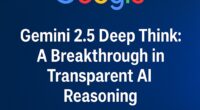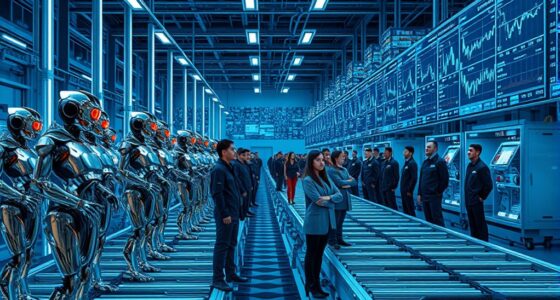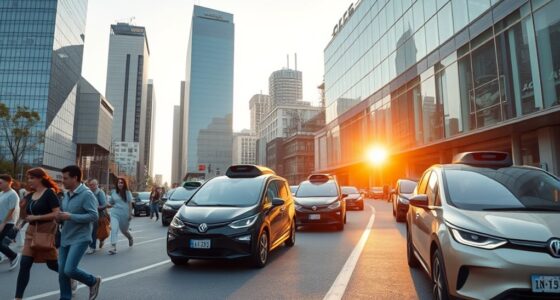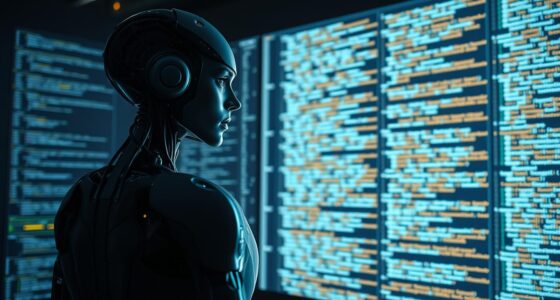Executive Summary
The provided sources, primarily “AI vs. Jobs: The Shocking 80% Problem Exposed” and “[Deep Dive] AI, Post-Labor Economics & The Future of Work – Thorsten Meyer AI,” detail an impending, rapid societal transformation driven by Artificial Intelligence. This transformation is projected to lead to a “post-labor economy” where human labor is no longer the primary driver of economic productivity or the primary mechanism for wealth distribution.
The sources emphasize that this shift is happening much faster than commonly anticipated, primarily affecting knowledge workers, and necessitating a fundamental re-evaluation of human skills, economic systems, and power structures. While the transition presents significant challenges like job displacement and wealth concentration, it also offers opportunities for unprecedented abundance and a redefinition of human purpose if navigated proactively through new social contracts and skill development.
Key Themes and Most Important Ideas/Facts
1. The Impending Post-Labor Economy and the “80% Problem”
The central theme is the imminent transition to a “post-labor economy,” driven by AI’s superior efficiency and cost-effectiveness. This is not a distant future but an “unprecedented in human history” shift that is already showing “early signs,” such as Klarna replacing 700 customer service agents with a single AI system while improving satisfaction.
- The 80% Problem: Studies suggest that “only about 20% of jobs today are intrinsically immune to AI automation,” meaning “eight out of ten current roles face significant disruption or complete replacement.”
- Targeting Knowledge Workers: Contrary to popular belief, AI is “not coming for manual laborers first. It’s targeting knowledge workers with laser precision.” Examples include AI outperforming junior lawyers in legal research and human doctors in diagnostic accuracy for cancer markers.
- Three Categories of Work:Completely Automatable Jobs: Tasks with “clear patterns, measurable outcomes, and don’t require human intuition” (e.g., data entry, basic accounting, routine legal research, content moderation). Duolingo significantly cut its contractor workforce using AI translation.
- Human-AI Hybrid Roles: Jobs that will “survive but transform dramatically,” requiring human judgment to “interpret AI outputs and apply them to complex, nuanced situations” (e.g., financial advisors focusing on client goals, marketing professionals on creative strategy).
- Purely Human-Centric Roles: Jobs “largely protected” due to requiring “physical embodiment in unpredictable environments, deep trust relationships built over time, or creative problem-solving that involves understanding human emotions and cultural nuances” (e.g., plumbers, therapists, teachers, ER nurses, executive relationship management).
2. The Compressed Timeline: “The Future Arrives Slowly, Then All at Once”
A critical insight is that the timeline for AI’s economic impact is much shorter than generally assumed by institutions like McKinsey and Brookings, who project shifts by 2030-2040.
- Exponential Adoption: “Each technological revolution happens faster than the one before it.” The timeframe for new technological paradigms settling has compressed from 7-18 years (2000-2020) to 3-8 years recently.
- Superintelligence by 2026-2027: Leading AI researchers at “frontier labs like OpenAI and Anthropic are talking about superintelligence arriving between 2026 and 2027.” This creates a “dangerous gap between reality and preparation” if economic impact lags capability.
- Hidden Infrastructure: AI deployment will be rapid because “every business already runs on cloud computing and software-as-a-service platforms.” AI capabilities will appear as “new features in software they’re already using,” allowing transitions “as quickly as a software update.”
- Human Underestimation of Exponential Growth: Our brains are wired for linear progression, causing us to “overestimate our preparation time” for exponential change, which appears gradual “until it becomes overwhelming.”
- Business Agility vs. Government Lag: Businesses will not wait for government guidance but will implement AI “as soon as they provide value,” accelerating adoption.
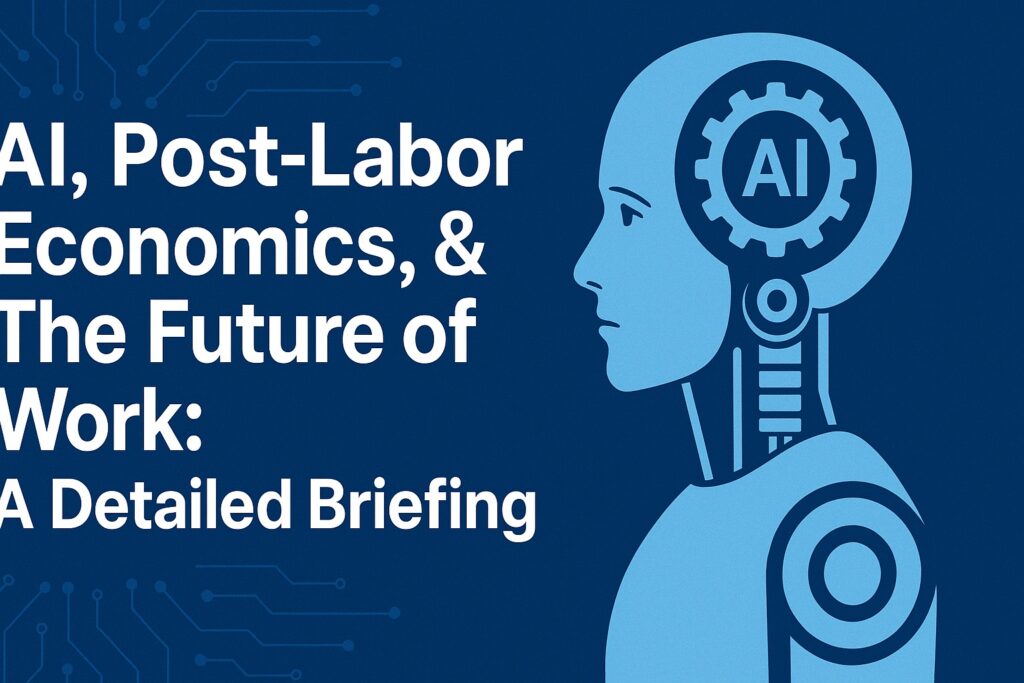
3. The Decoupling Revolution: Productivity Without Human Labor
The sources highlight a “complete separation of economic productivity from human labor,” a fundamental shift where “economic growth no longer equals widespread prosperity.”
- Massive Output with Fewer Workers: Companies are achieving “massive increases in output without proportional increases in workforce,” often while “reducing their headcount entirely” (e.g., Google’s market value far exceeding Ford’s with significantly fewer employees, and Apple generating immense revenue with a relatively small direct workforce).
- Productivity Paradox/Revolution: Human workers become “incredibly productive when paired with AI tools,” but this “increased capability reduces the need for human workers rather than increasing it.”
- Flaws in Unemployment Statistics: Official unemployment metrics “miss the real story,” failing to capture “underemployment” (e.g., college graduates in retail), “delayed career progression,” or those who have “given up looking for work that matches their education and skills.”
- Demographic and Geographic Impacts:Young Workers: Feel the impact “first and hardest,” with entry-level positions disappearing and “career ladders get shorter.” Entry-level jobs in the UK dropped by 32% since ChatGPT’s release.
- Older Workers: May retain jobs due to deep industry knowledge but lose support staff to AI.
- Geographic Vulnerability: Small cities and rural areas are vulnerable as companies consolidate operations in major metropolitan areas, leading to “population concentration in a handful of major cities.”
- Wealth Concentration: Companies implementing AI gain “massive competitive advantages,” leading to benefits flowing “primarily to business owners and shareholders rather than workers.”
- Psychological Shift: The “social contract that connected individual effort to economic rewards is dissolving,” leading to college graduates finding their degrees don’t guarantee middle-class lifestyles.
4. The New Value of Human Skills: Communication as a “Superpower”
In a world where AI excels at technical tasks, uniquely human skills become paramount for job security and value.
- Shift in “Skilled Labor”: “Technical expertise alone doesn’t guarantee value anymore.” The new skillset involves the “ability to work with AI systems, interpret their outputs, and apply human judgment to complex situations.”
- Human Connections are Key: “Job security now depends more on your ability to build human connections than on your technical expertise.” This includes software engineers translating complex concepts, doctors combining AI diagnostics with bedside manner, and teachers personalizing learning with emotional support.
- Rewarding Different Personality Types: The shift favors individuals “skilled at reading social situations, building trust, and navigating complex human emotions” over “introverted specialists who preferred working with data and systems.”
- Communication as the Most Valuable Skill: “The uniquely human ability to connect, persuade, and build trust with other people” becomes the “most valuable asset.”
- Emotional Intelligence: Reading subtle cues, understanding unspoken concerns.
- Cultural Nuance: Adapting communication to different backgrounds (e.g., direct vs. indirect communication with AI).
- Trust Building: Consistent behavior, shared experiences, vulnerability.
- Presentation Skills: Translating complex AI outputs into actionable strategies for human audiences.
- Negotiation Abilities: Handling the psychological aspects of deal-making beyond pure logic.
- Economic Moat: “Your unique combination of communication skills, cultural understanding, and emotional intelligence remains exclusively yours” as AI systems become commoditized.
5. The Future of Money and Power: Beyond Wage Labor
With human labor decoupled from productivity, fundamental questions arise about wealth allocation, currency, and power dynamics.
- Money’s Enduring Role: Even in an automated economy, money remains essential for “making those allocations” of diverse goods and services.
- Three Monetary Futures:Hyperinflation from abundance: If production costs near zero.
- Deflation from reduced demand: If mass job loss causes demand collapse.
- Algorithmic management: AI systems precisely managing money supply.
- Central Bank Digital Currencies (CBDCs) and Corporate Stablecoins: Over 130 nations are piloting CBDCs, enabling “programmable money that automatically distributes payments based on predetermined criteria.” Corporations like Walmart and Amazon are exploring stablecoins, aiming to become “monetary authorities in their own right.”
- Bitcoin’s Potential: Offers “genuine decentralization and global acceptance” as a neutral standard for exchange between diverse digital tokens.
- Distribution Mechanisms: The central challenge is “fundamentally reimagining how society decides resource allocation when the traditional mechanism [wage labor] disappears.” Programmable money and algorithmic distribution systems could distribute income based on “citizenship, community contribution, or other criteria.”
- The Power Paradox: Labor’s traditional leverage (“the ability to withhold labor”) “no longer matters when machines can do the work instead.” This has been eroding since the 1950s, with AI representing “the final phase.”
- Alternative Sources of Power:Ownership Rights: Cooperative business models, where workers collectively own companies.
- Data Ownership: Individuals claiming control over personal information (e.g., GDPR’s “right to be forgotten”).
- Intellectual and Physical Property: Creators controlling ideas, communities organizing around land/natural resources.
- Collective Citizen Influence: Consumer choices, investment decisions, political participation (e.g., boycotts, shareholder activism).
- Abundance vs. Equitable Distribution: “Abundance doesn’t automatically lead to equitable distribution.” New mechanisms are needed to ensure the benefits of AI-driven productivity are “distributed fairly rather than concentrated among the few who own the AI systems.”
6. The Creator Economy: A Harsh Reality Check
The sources debunk the widespread illusion of easy financial success in the creator economy, highlighting its inherent attention scarcity.
- Hockey Stick Curve: Income distribution is “almost flat for 99% of creators,” with dramatic success only for the “top 1%.” The “average OnlyFans creator makes around $180 per month.”
- Finite Human Attention: “Human attention is finite,” leading to intense competition where “most will inevitably lose” when millions of creators compete for limited attention.
- Platform vs. Business Model: Low barriers to entry for platforms (YouTube, Substack) don’t equate to sustainable business models, which require professional marketing, strategy, and content creation. “Followers don’t automatically equal income.”
- AI Intensifies Competition: AI tools democratize content creation, but also “flood markets with new creators,” making it “progressively more difficult” to stand out as everyone gains similar capabilities.
- Platform Dependencies: Creators face “constant uncertainty” due to platform control (demonetization, shadowbanning, policy changes).
- Subscription Fatigue: Consumers are selective, leading to “intense competition” for paid subscriptions. Less than 1% of an audience often pays for content.
- Practical Wisdom: Treat creative ventures as “passion projects that might become profitable” and “diversify revenue streams.” Focus on genuine creation over immediate monetization pressure.
7. The Regulation Riddle and The Unemployment Illusion
The sources touch on the challenges of AI regulation and the inadequacy of current economic metrics.
- Regulatory Chaos: The current environment is characterized by “regulatory chaos,” with conflicting approaches (US reactive, EU proactive) stifling innovation. “Innovation actually requires regulatory clarity, not regulatory absence.”
- Smart Regulation Drives Innovation: Examples like aviation safety and automotive emissions show how “intelligent regulation” and “standards drive innovation” and “shape technology development in positive directions.”
- Tech Companies Desire Regulation: Major AI developers want “smart regulation that establishes clear boundaries” because “unsafe AI systems threaten their business models.”
- Unemployment Metrics Flawed: Official unemployment rates “miss the real story,” failing to capture underemployment, delayed career progression, or those who have given up looking for work.
- Generational Disconnect: The “generational wealth divide provides clearer evidence of systematic economic shifts,” with Gen Z facing housing costs significantly higher relative to income than previous generations.
- Psychological Impact: The disconnect between official statistics and lived experience (“job market that looks healthy on paper but feels broken in reality”) “creates confusion and frustration” and erodes trust in institutions.
8. Surviving the Great Changeover: Cautious Optimism
Despite the profound challenges, the sources express cautious optimism, emphasizing that proactive preparation and institutional adaptability can prevent societal collapse.
- Pre-Existing Problems: Problems like “deaths from despair” existed before AI, indicating deeper systemic issues.
- Modern Democracies’ Resilience: Unlike past revolutions, modern democracies have “built-in pressure release valves” through federal systems, civil society organizations, regular elections, and free press, offering “mechanisms for peaceful change.”
- Danger of Institutional Capture: “Elite capture, democratic capture, corruption, gerrymandering, and skewed courts” are significant threats that “could block necessary adaptations” and lead to social breakdown.
- Warning and Preparation: Unlike previous transitions, “we can see the change coming.” This “visibility creates opportunities for proactive preparation” for individuals, communities, governments, and educational institutions.
- American Adaptive Capacity: The US has navigated major challenges (Great Depression, World Wars, Civil Rights) without collapsing, suggesting it has the capacity to adapt to the AI transition.
- Positive Outcomes Possible: AI abundance could lead to “unprecedented prosperity,” freeing people for “creative, educational, and social activities,” and helping manage environmental challenges.
- Preparation is Key: The transition is “challenging but manageable with proper preparation and institutional flexibility.”
Conclusion and Call to Action
The sources conclude with a strong call to action: “Post-labor economics isn’t about job loss. It’s about redefining human value and purpose.” Individuals are urged to prioritize the development of uniquely human skills.
- Irreplaceable Skills: Focus on “communication skills, emotional intelligence, and maintaining control over your data and digital agency.”
- Redefining Worth: In the coming age, “your worth isn’t measured by how many hours you work but by how well you connect with other humans, solve creative problems and adapt to change.”
- Proactive Adaptation: The transition “is already happening. Start preparing now.”
Ultimately, the future “depends on how well society prepares for change, how effectively institutions adapt to new realities and how committed people remain to democratic problem solving.”
FAQ: Navigating the AI-Driven Post-Labor Economy
1. What is the “80% problem” and how will AI impact the job market?
The “80% problem” refers to studies suggesting that approximately 80% of current jobs are susceptible to significant disruption or complete replacement by AI automation. This shift is unprecedented in human history, moving towards a “post-labor economy” where economic productivity is increasingly decoupled from human labor. Unlike previous industrial revolutions that primarily affected manual labor, AI is now precisely targeting knowledge workers, mastering tasks like legal research, financial analysis, and medical diagnosis with greater speed and accuracy than humans. This means that while 20% of jobs may be “intrinsically immune” to automation, the vast majority face transformation.
Jobs can be categorized into three types:
- Completely automatable jobs: These involve tasks with clear patterns, measurable outcomes, and no need for human intuition (e.g., data entry, basic accounting, content moderation).
- Human-AI hybrid roles: These roles will survive but change dramatically, requiring human judgment to interpret AI outputs and apply them to complex situations (e.g., financial advisors, marketing professionals).
- Purely human-centric roles: These jobs are largely protected, requiring physical presence in unpredictable environments, deep trust relationships, or creative problem-solving involving human emotions and cultural nuances (e.g., plumbers, therapists, teachers, nurses, executive relationship managers).
2. What skills will be most valuable in a post-labor economy?
Traditional career advice, focusing on technical skills and credentials, is becoming outdated. The new valuable skillset revolves around the ability to work with AI systems, interpret their outputs, and apply uniquely human judgment. This emphasizes “human connections” over purely technical expertise.
The most valuable skill will be communication, specifically those aspects that algorithms cannot replicate:
- Emotional intelligence: Reading subtle cues, understanding unspoken concerns, and responding appropriately to emotional states.
- Cultural nuance: Adapting communication styles based on different backgrounds.
- Trust-building: Developing relationships through consistent behavior, shared experiences, and vulnerability.
- Presentation skills: Translating complex AI outputs into actionable strategies for human audiences.
- Negotiation abilities: Handling the psychological aspects of deal-making, understanding human motivations beyond pure logic.
Companies are already restructuring to allow humans to focus on creative problem-solving, relationship management, and strategic thinking, while AI handles routine analysis.
3. How quickly is this AI transformation expected to happen, and why are traditional forecasts misleading?
Most traditional institutions (like Brookings and McKinsey) predict major AI-driven economic shifts by 2030-2040, giving a false sense of security regarding the timeline. However, technological adoption has accelerated dramatically in recent decades, with new paradigms settling in 3-8 years, much faster than previous industrial revolutions (e.g., steam engine, printing press). Leading AI researchers now project superintelligence arriving between 2026 and 2027.
The “timeline trap” stems from several factors:
- Exponential growth: Our brains are wired for linear progression, underestimating the rapid acceleration of exponential curves.
- Existing infrastructure: AI isn’t a completely new technology requiring fresh infrastructure; it’s an additional layer on existing cloud computing and software-as-a-service platforms, allowing for deployment as quickly as a software update.
- Business competition: Companies will adopt AI rapidly to gain competitive advantages, not waiting for regulatory guidance or external crises.
This means the significant changes discussed could arrive in the next 3-5 years, not 15-20, leading to a dangerous gap between reality and preparation if individuals and institutions operate under outdated assumptions.
4. What is the “decoupling revolution” and its implications for economic growth and prosperity?
The “decoupling revolution” refers to the complete separation of economic productivity from human labor. Historically, economic growth meant hiring more workers. Now, companies can achieve massive increases in output and trillion-dollar valuations with significantly smaller workforces, relying heavily on algorithms rather than people (e.g., Google’s market value vs. Ford’s, Apple’s revenue with relatively fewer direct employees).
This has profound implications:
- Job creation vs. elimination imbalance: New AI-related jobs are emerging, but they require dramatically fewer headcounts, meaning dozens of traditional roles become obsolete for every new one created.
- Stagnant wages and wealth concentration: Economic growth (GDP, corporate profits, stock markets) can increase while median wages stagnate or decline, and benefits flow primarily to business owners and shareholders, not workers.
- Demographic impacts: Young workers face disappearing entry-level positions and shorter career ladders, leading to financial instability and delayed milestones. Older workers may retain jobs but lose junior support staff to AI.
- Geographic implications: Small cities and rural areas are vulnerable as companies consolidate operations in major metropolitan areas to attract specialized AI talent.
- Psychological impact: The traditional bargain of hard work, education, and skill leading to economic security is breaking down, causing uncertainty for college-educated professionals and skilled laborers.
The core issue is that human labor is no longer necessary for economic production, dissolving the social contract that connected individual effort to economic rewards.
5. How will money and resource allocation change in a post-labor economy?
Even in a fully automated economy, money will remain essential for allocating resources and making choices about goods and services. However, its function will evolve dramatically as wage labor ceases to be the primary mechanism for income distribution.
Three monetary futures are possible:
- Hyperinflation from abundance: If AI drives production costs to near zero, governments might print unlimited money, leading to hyperinflation.
- Deflation from reduced demand: If mass job displacement leads to no income for most people, demand could collapse, causing deflation.
- Algorithmic monetary stability: AI systems could precisely manage the money supply.
Governments are already piloting central bank digital currencies (CBDCs), which offer programmable money for automated distribution based on non-employment criteria (e.g., citizenship, community contribution). Major corporations are also exploring their own stablecoins. Bitcoin’s decentralized nature could make it a neutral global reserve currency.
The challenge is not technological but political and social: who controls the algorithms that distribute money, and how do we ensure equitable distribution and prevent new forms of economic control and wealth inequality? Monetary policy will need to adapt as traditional tools (like interest rates affecting employment) become irrelevant. Financial security may depend more on accessing and influencing these distribution systems than on traditional employment.
6. What happens to worker power when labor loses its leverage to AI?
Historically, worker power stemmed from the ability to withhold labor through strikes, forcing concessions from employers. AI systems, however, can maintain production during a strike, eliminating this fundamental source of leverage. Labor is “inalienable and perishable,” whereas AI can work continuously, without rest, benefits, or job security, and can be deployed instantly.
This shift necessitates exploring alternative sources of power:
- Ownership rights: Cooperative business models where workers collectively own companies, allowing them to directly benefit from increased productivity due to automation.
- Data ownership: Individuals claiming control over their personal information (as seen with GDPR), creating leverage against tech giants dependent on data.
- Intellectual property rights: Creators maintaining control over their valuable ideas and creative works.
- Digital property rights: Control over data ownership and platform governance.
- Physical property: Land and natural resources remain valuable as they cannot be digitized or automated.
Citizens will need new forms of collective bargaining power through consumer choices (boycotts), investment decisions (shareholder activism), and political participation, influencing companies’ reputations and social licenses. This highlights the need for new institutions to give citizens a voice in an AI-dominated economy, ensuring that the benefits of AI-driven abundance are distributed fairly rather than concentrated among a few.
7. Is the “creator economy” a viable alternative for widespread economic security in the AI era?
The “creator economy” is often presented as a solution for individuals to monetize their talents. However, the reality reveals a “hockey stick curve” distribution, where only the top 1% of creators earn significant income, while the vast majority (99%) earn very little. For example, the average OnlyFans creator makes around $180 per month.
This extreme concentration is due to the finite nature of human attention. Millions of creators compete for the same limited 24 hours in a day, making widespread success mathematically impossible. While barriers to entry for starting a platform are low, building a large enough audience for meaningful income requires professional-level marketing, psychology, business strategy, and content creation skills.
AI tools further intensify this competition by democratizing content creation (e.g., AI assisting with scriptwriting, video editing, artwork), leading to an exponential increase in content. While AI boosts individual productivity, it also makes it harder to stand out. Aspiring creators often fall into the psychological trap of believing talent plus effort automatically equals financial success, but creative markets operate differently from traditional employment. Platform dependencies (e.g., YouTube, Instagram, TikTok) also create risks, as platforms can change policies, demonetize, or ban accounts without warning, leading to constant uncertainty for creators who don’t control their own infrastructure.
Practical wisdom suggests treating creative ventures as passion projects with diversified revenue streams, building sustainable income elsewhere, and viewing any creative income as a bonus rather than a primary plan to avoid financial disaster.
8. How will AI regulation affect innovation and societal stability?
The current regulatory landscape for AI is chaotic, with proposals like a decade-long ban on state-level AI regulations creating uncertainty. Even tech companies often oppose a complete lack of regulation, understanding that innovation requires regulatory clarity, not absence. Clear guidelines are essential for long-term investments in AI development, research, and resource allocation.
Different regulatory approaches exist:
- America: Traditionally reactive, addressing problems after they emerge, fostering dynamic startups but increasing risks of harmful products.
- Europe: Proactive, attempting to prevent harm through comprehensive frameworks like GDPR, providing clearer long-term guidance for sustainable technology development.
- China: State-directed innovation, using government influence to stimulate competition and guide technological advancement.
Historical examples like aviation and automotive emissions demonstrate how smart regulation drives innovation and public safety, rather than stifling it. Major AI developers themselves invest in safety research because unsafe AI systems threaten their business models and public trust.
The challenge lies in managing federal versus state regulatory authority, as conflicting rules could fragment the AI market. The optimal level of AI regulation involves complex trade-offs: too little risks harmful deployment and public backlash, while too much could slow innovation and drive development overseas. The most successful frameworks will be adaptable, flexible, and responsive to evolving challenges.
While fears of social collapse due to AI displacement are understandable, historical transitions suggest that modern democracies have “pressure release valves” through information transparency, federal systems (allowing state-level experimentation), and democratic institutions (elections, courts, free press). However, risks like institutional capture and corruption could block necessary adaptations, creating frustration. Proactive preparation by individuals, communities, and institutions is key to a manageable transition, allowing society to adapt gradually rather than catastrophically. The aim is to ensure AI’s benefits are distributed fairly, not concentrated among a few.NotebookLM can be inaccurate; please double check its responses.

